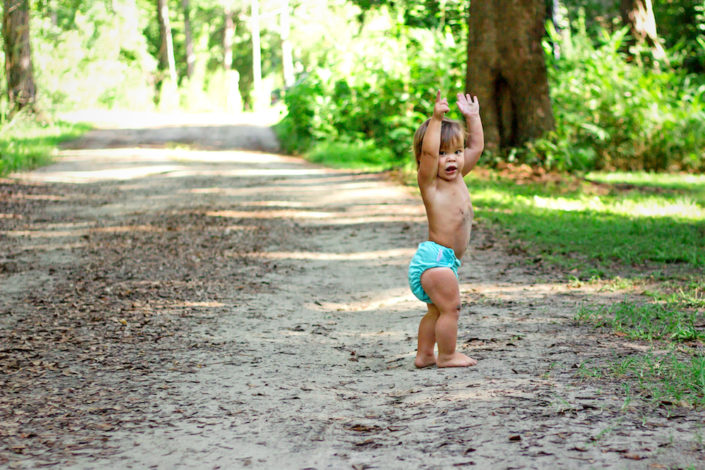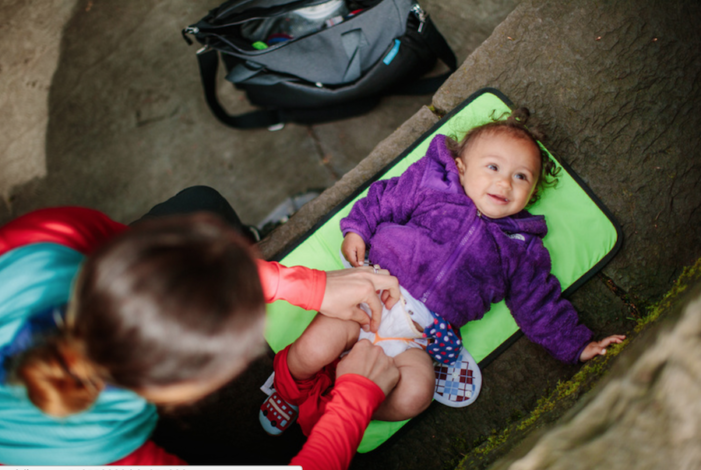Cloth Diapering while Hiking
I’ve heard it a few times now. “We do cloth at home, but use disposables on hikes… just in case.” Just in case what? Lets dig into our cloth diaper hiking fears and some simple suggestions to overcome them.
Thinking back to when I first started hiking with my baby, I think it comes down to 2 main concerns:
 Fear #1: The bulk/weight of carrying all your gear can be daunting. Believe me I understand. I am a “be prepared for everything” sort of mom. The only person I know who wants to bring more gear than I do is my husband. We bought a diaper bag designed for twins for our longer outings. We only have 1 baby. Solution? You can bring ALL THE THINGS! Leave them in the car for those “just in case” situations. Take only absolute necessities on the trail.
Fear #1: The bulk/weight of carrying all your gear can be daunting. Believe me I understand. I am a “be prepared for everything” sort of mom. The only person I know who wants to bring more gear than I do is my husband. We bought a diaper bag designed for twins for our longer outings. We only have 1 baby. Solution? You can bring ALL THE THINGS! Leave them in the car for those “just in case” situations. Take only absolute necessities on the trail.

- Carrying ALL the things!
- Leaks
 Fear #1: The bulk/weight of carrying all your gear can be daunting. Believe me I understand. I am a “be prepared for everything” sort of mom. The only person I know who wants to bring more gear than I do is my husband. We bought a diaper bag designed for twins for our longer outings. We only have 1 baby. Solution? You can bring ALL THE THINGS! Leave them in the car for those “just in case” situations. Take only absolute necessities on the trail.
Fear #1: The bulk/weight of carrying all your gear can be daunting. Believe me I understand. I am a “be prepared for everything” sort of mom. The only person I know who wants to bring more gear than I do is my husband. We bought a diaper bag designed for twins for our longer outings. We only have 1 baby. Solution? You can bring ALL THE THINGS! Leave them in the car for those “just in case” situations. Take only absolute necessities on the trail.
Quick note: This actually took my a while to realize. Disposables are easier when you're out because the dirty ones go in the trash instead of coming home with you. However, if you have to change a diaper when you're out on the trail, the dirty diaper (regardless of type) is coming with you. Don't let the fear of carrying dirties on the trail hinder you. Thats a hiking with a baby issue, not a cloth diapering issue!Fear #2: Leaks. By now you’ve probably been pooped and peed on. Everyone survived. Of course you don’t want poop anywhere the littles can touch it, but you are not a terrible parent if your kid has to wear pants with a bit of pee on them for an hour or so. Also, disposable diapers are not leak-proof. In fact, my experience has been that cloth is better at containing poo than 'sposies. Pee.... well, see #4. Many of my suggestions will feel a bit obvious, but hopefully reading all of them together will convince you that you CAN hike in cloth diapers.
Cloth Diapering on the Trail
1. Choose the “right” hike
- Really nervous? Find a stroller hike for your first cloth diapered hike. That way you can bring lots of gear in the stroller.
- Find a hike that is a reasonable time to go without a change. If you want to hike longer than that, see if you can find a location to do a loop twice so that you can pass your car (and change a diaper) at the midway point.
- Can’t find a good option? Lead a hike somewhere that works for you!
2. Get there early and plan to leave later than the posted time
- Change the kid RIGHT before you head out on the trail. Everyone will wait for you. It’s OK. We really don’t mind at all.
- Ideally, get there early enough to feed the littles ahead of time too. Eating tends to encourage the digestive system to be active, making that diaper change right before the hike more likely to be ummm… productive.
- Assume you’ll need to change a diaper again after the hike and before you leave. Leave enough time between the hike and any other appointments afterwards.
3. Bring only essentials on the trail
- Carry a disposable on the trail. Yep, my suggestion for hiking in cloth diapers is to take a disposable on the trail. As a mom that wants to bring everything, this was my solution. The baby wears cloth on the hike. There are cloth diapers in the car for the post-hike change. The disposable is “just in case!” I have never used my just in case disposable.
- What’s the highest number of wipes you’ve used in a single diaper change? Add 2 or 3. Fold them up and put them in a zip top sandwich baggie. For cloth wipes, add some water (or whatever you use as a wipe solution) to the baggie.
- Disposable “wet bag.” This took me way too long to figure out. In my head, dirty diapers go into the reusable wet bag. Someone gifted us a roll of disposable bags and eventually I realized that I could use them with cloth diapers.
- ID, insurance card, etc.
- Snacks, milk/formula/boobs, water.

4. Preventing Leaks in Cloth Diapers
Cloth diapering parents get used to minor pee leaks pretty quickly. Its really not the end of the world, but still not ideal if you’re out on the trail an hour’s walk from your car. After 20 months of cloth diapering, here are our go-tos for overnight and long hikes.The basic formula: cotton prefold + doubler + “the right” cover.
We use Cloth-eez prefolds, and love them. They are a little pricier than some prefolds, but can hold a lot of liquid. We use Thirsties hemp doublers because they add absorbency without bulk and were the best value we could find. However, hemp absorbs slowly so it must be placed UNDER a faster absorbing layer. For all in ones, consider a cotton doubler (instead of hemp) inside your diaper. Being a scientist, of course I tested things myself. Here are the results of my absorbency testing:- Medium size Cloth-eez pre-fold: 400 ml
- Thirsties hemp double, large: 150 ml
- Size 4 Bambo Nature disposable: 650 ml
Give it a Go!
So that’s it! It may seem a bit daunting at first, but it’s really not much more complicated than hiking in disposables. The most important thing is to just try it rather than assuming your fears are valid. Even if it does end up being a disaster (it won’t!) everyone out on the trail with you will rally and get you through it with ease.Related Content




Comments